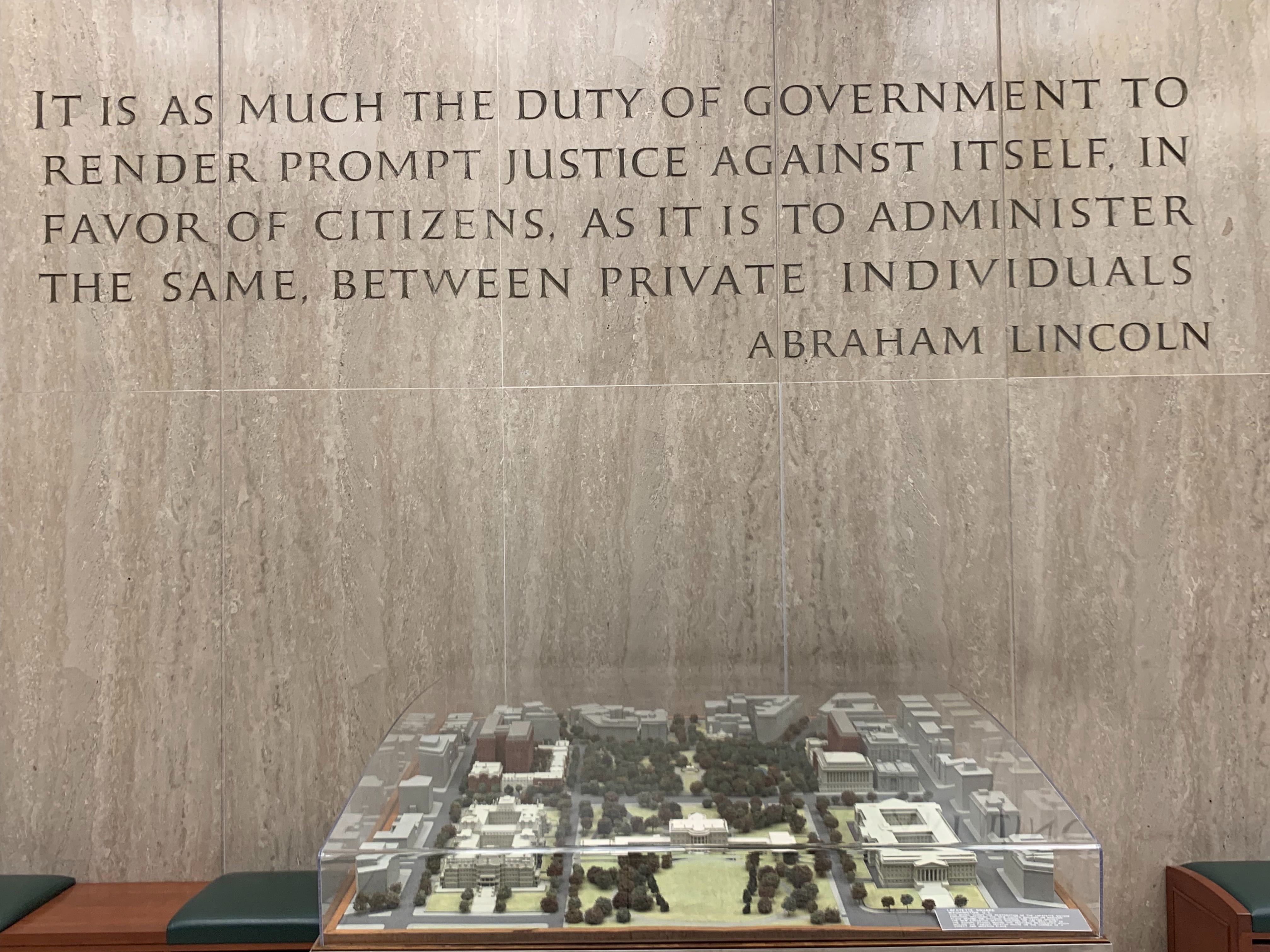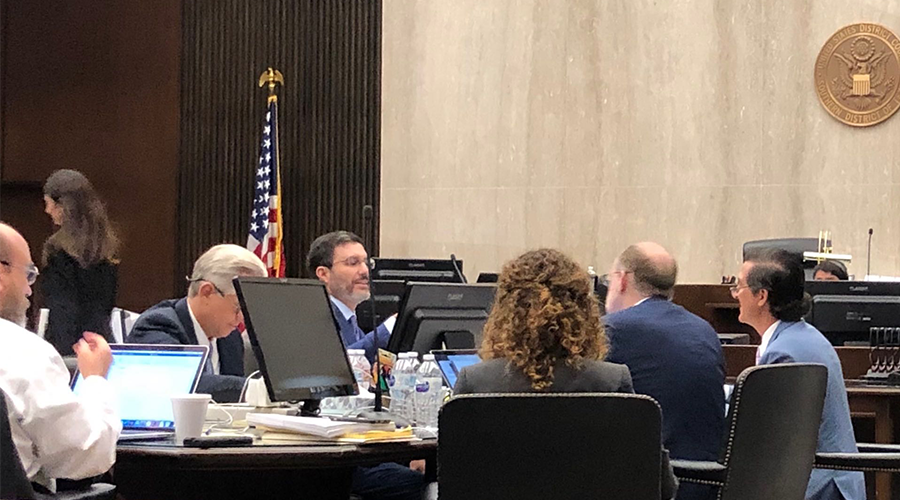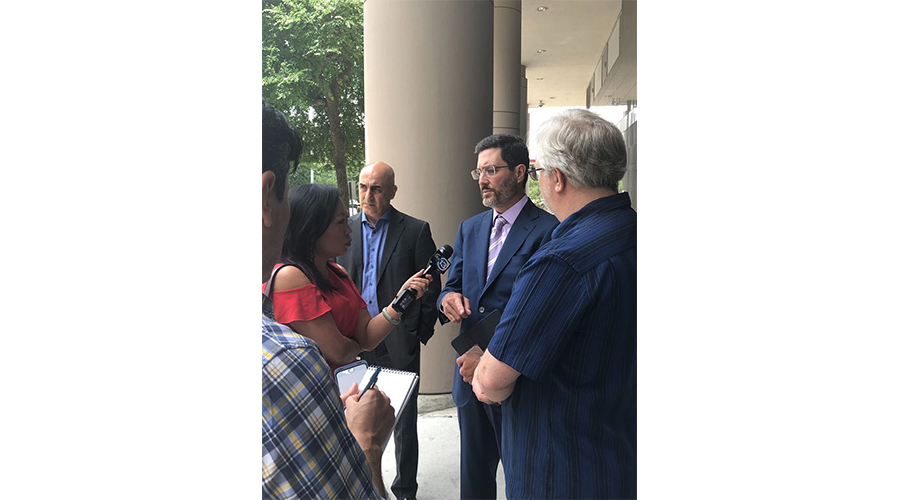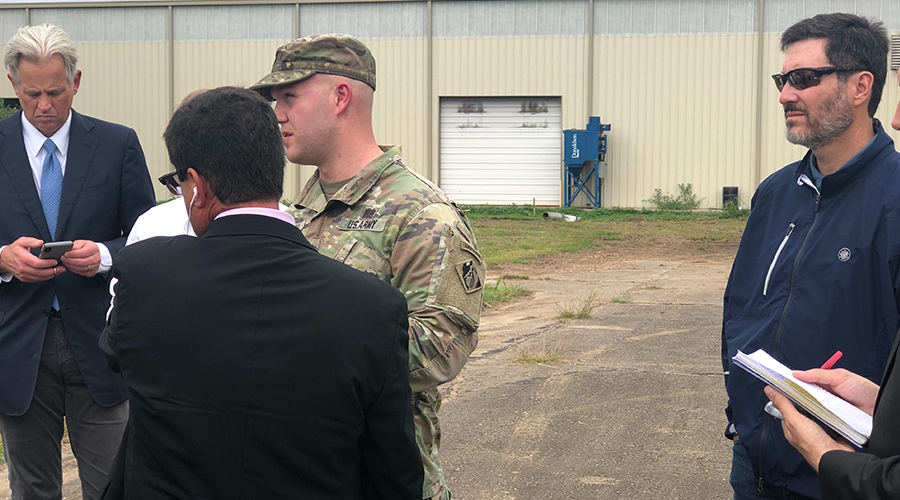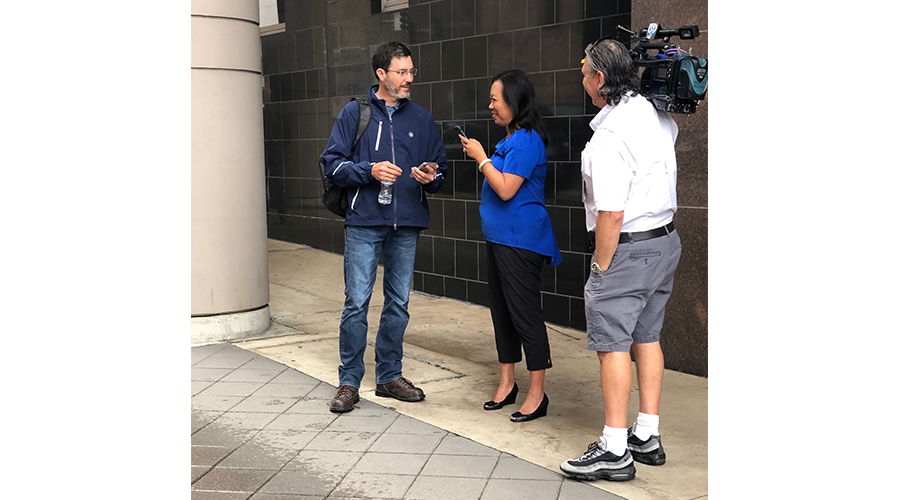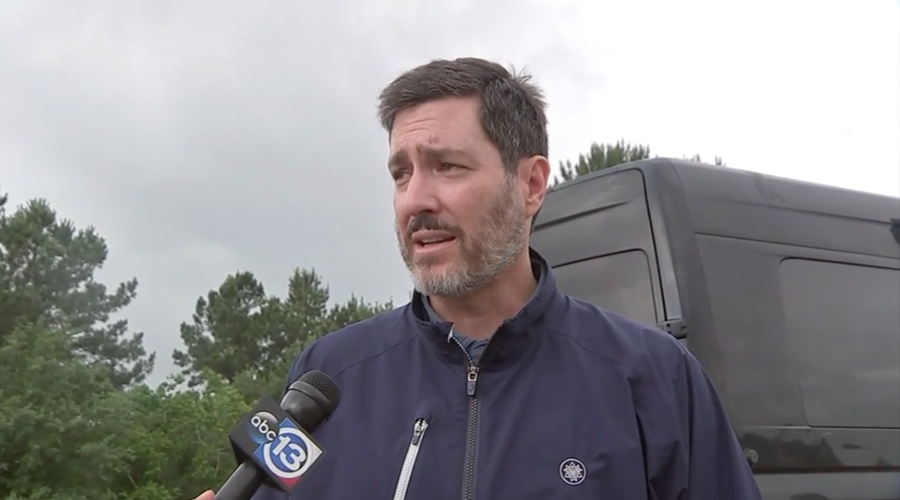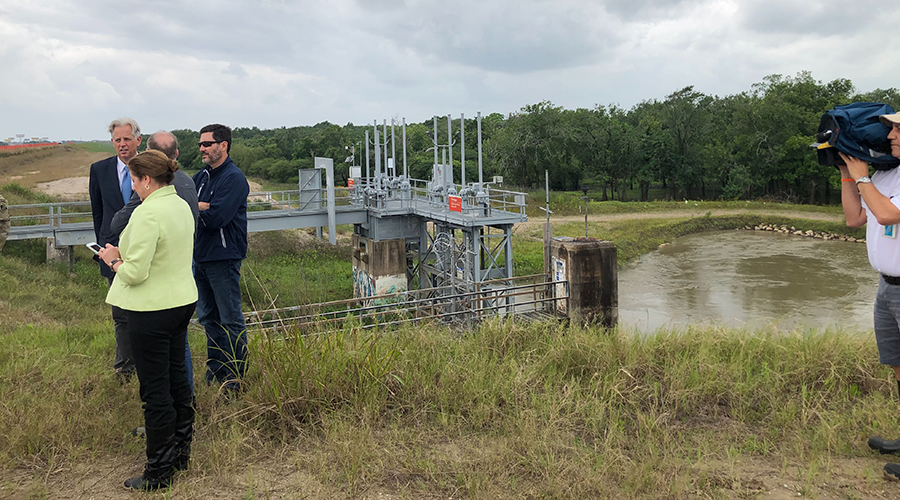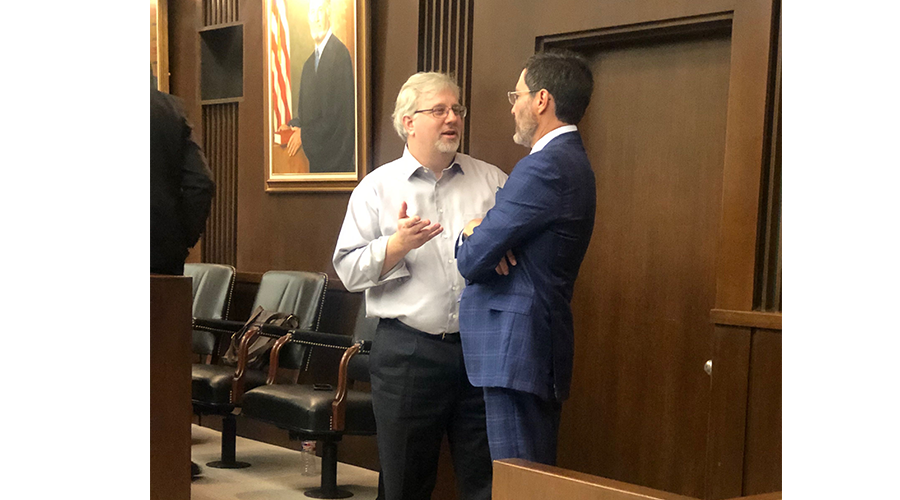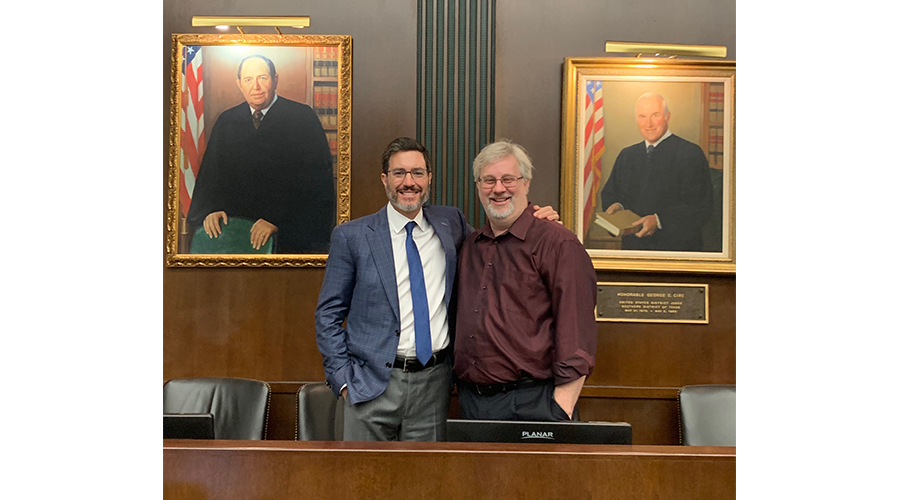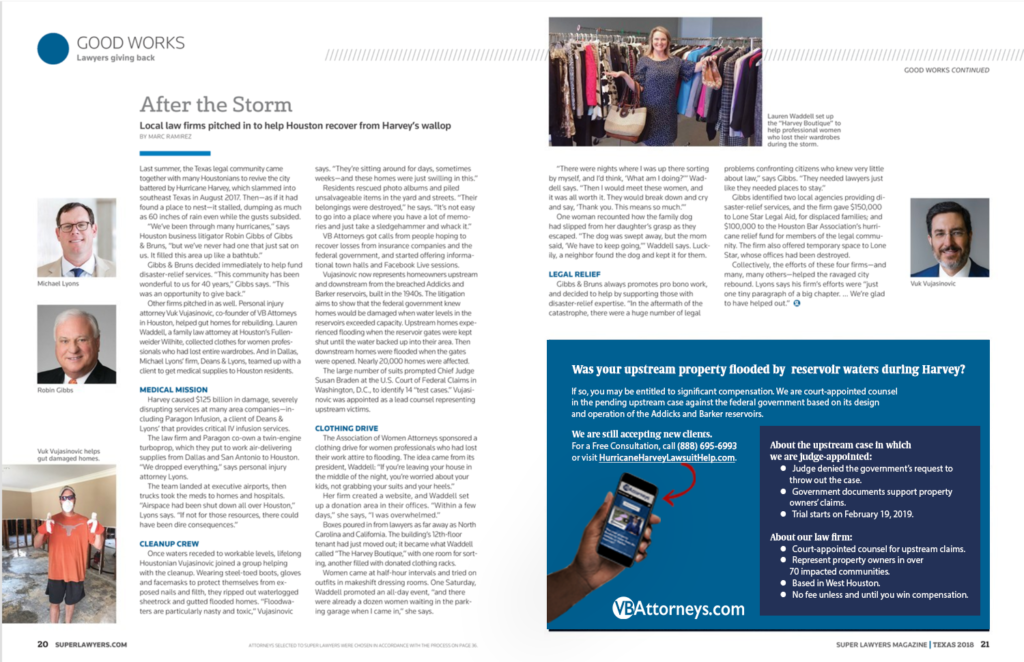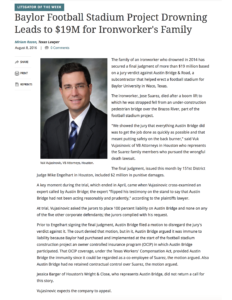Federal Judge Awards Compensation to Test Case Upstream Homeowners
The compensation order for the six upstream test cases is in! With interest and other allowable items, and reductions for certain offsets, the numbers for the test cases who owned homes that flooded are going to average compensation of up to around $300,000 each. This includes interest beginning in August 2017 at 3.62% compounded semi-annually.
Impacted homeowners who have not hired counsel are strongly advised to do so as soon as possible, as the time to file these claims is quickly running out.
The Judge awarded compensation in three categories for the test cases who sustained structural flooding.
First, real property. The Judge characterized this category as follows: “The award for structurally flooded properties reflects both the fact that the easement grants the government the permanent right to impound water within the homes on the properties, and the structural damage the government caused by taking the easement.”
Second, personal property. This includes “personal property, fixtures and improvements” that were located at the flooded property and destroyed or damaged, such as vehicles, furniture, belongings, etc.
Third, dislocation costs. This is basically money spent on alternative lodging while the flooded property was being restored, such as renting a hotel or a temporary home.
The Judge reduced the awards by the amounts of any direct payments from FEMA.
Every case is individual and compensation will be determined based on each person’s individual damages. The test cases are examples that teach us the methodology to be used for the rest of the cases.
It is recommended all impacted upstream homeowners gather and preserve the following materials:
● Documentation of costs to restore and/or repair your flooded home;
● A list of your personal property, fixtures and improvements that were damaged or destroyed, any photos you may have of these items (before and/or after the flooding), and any documentation you may have indicating the value of such items (when first acquired and/or at the time of the flooding); and
● Documentation of any costs you incurred for temporary lodging while your flooded home was being restored / repaired.
Vuk Vujasinovic of VB Attorneys, who represents homeowners in all of the impacted upstream communities, says “Our goal is to use these victories in the test cases and apply them to the claims of all of our clients in order to get them the just compensation they are owed under the 5th Amendment to the U.S. Constitution.”
Vujasinovic estimates the collective value of the claimed damages exceeds $1 Billion. Vujasinovic points out that anyone who does not hire counsel and file their claim soon will be prohibited from ever recovering any compensation in this matter.
Federal Judge Refuses to Certify Class Action in Addicks and Barker Flood Takings Litigation
Case Will Proceed on an Individual Basis
On December 15, 2021 Judge Charles F. Lettow of the United States Court of Federal Claims declined to certify a class action in litigation in which thousands of owners of private property located behind the Addicks and Barker reservoir project in Harris County and Fort Bend County, Texas claim the government took their property without just compensation by diverting flood water during Hurricane Harvey in 2017.
Vuk Vujasinovic of VB Attorneys is one of the court-appointed counsel in the litigation and was on the team that won a liability finding for thirteen “test cases” in December 2019. Vujasinovic is designated by the federal judge “to ensure the interests of individual plaintiffs are represented,” and is not among the counsel responsible for class action matters.
Vujasinovic says a motion to certify a class action was filed by other counsel, and denied by Judge Lettow. Judge Lettow’s order indicates the motion for class certification was “DENIED both because of the timing of their request and their failure to satisfy the [necessary] criteria.” Vujasinovic explains that because of this ruling, flood victims should not expect to receive any kind of class action notice in the mail, or otherwise, through which they could join the lawsuit. Instead, Vujasinovic urges flood victims to hire individual counsel now.
Vujasinovic, who represents flood victims in all of the impacted upstream communities, says the litigation will continue to proceed on an individual basis as it has since late 2017. The next step is a trial to determine the just compensation for six of the test cases, which is anticipated to occur in Houston, Texas in March 2022. “The goal is to use our 2019 test case liability victory and apply it to the claims of all of our flood victim clients in order to obtain the just compensation they are owed under the 5th Amendment to the U.S. Constitution.”
Vujasinovic notes that in issuing the December 2019 liability order, Judge Lettow ruled that the government owns a permanent flowage easement over every property that flooded due to the government’s project during Hurricane Harvey. Vujasinovic estimates that 10,000 to 12,000 properties are burdened by this permanent easement, and that the total claimed damages exceed $1 billion.
According to Vujasinovic, now that it is known there will be no class action, it is particularly important for flood victims to hire individual counsel who can enforce their constitutional property rights and obtain the correct amount of just compensation. “Any flood victim who does not properly file their case by the applicable deadline risks being forever barred from recovering any just compensation. They will be giving the government a permanent flowage easement over their property for free. The government can flood their property any time it rains hard enough, without compensation. The government wants as few flood victims as possible to hire counsel and file claims so it won’t have to pay them anything, so it can save as much as possible off the estimated $1 billion it collectively owes property owners in our local communities upstream of the dams.”
Scope and Orders
The Judge in the Upstream Addicks & Barker case entered an order on April 30th, 2020 that was a big win for property owners on 3 important issues. First, the date of the government’s taking was in 2017 and not 1945, so property damage calculations will be based on fair market values as of 2017. Second, the scope of the easement is as narrow as possible under the circumstances. Third, upstream property owners are entitled to seek consequential losses, such as personal property, contents, fixtures, and improvements.
The government argued for a date of taking in 1945 (which would drastically lower property damage assessments), for a broad scope of the easement that would extend even to properties that did not flood in Harvey, and for property owners to be prohibited from seeking to recover consequential losses. Fortunately, the Judge ruled against the government on all these points.
You can find and read the official order under the resources tab or click here.
Here's What You Need to Know About the Compensation Phase
Following the trial victory in the upstream test cases, the compensation phase has now begun. The Judge has entered various deadlines in the compensation phase, but no trial date yet. It is anticipated that the trial of the compensation test cases may occur in November 2020.
The Judge designated the following six properties as compensation test cases:
- Test Property 1: Owner of a single-family residential home behind Barker in Kelliwood Park that sustained structure flooding
- Test Property 2: Owner of single-family residential home behind Addicks in Bear Creek that sustained structure flooding
- Test Property 3: Renter of a single-family residential home behind Addicks in Mayde Creek Farms that sustained structure flooding
- Test Property 4: Owner of a single-family residential home behind Barker in Canyon Gate that sustained structure flooding
- Test Property 5: Owner of a single-family residential home behind Barker in Kelliwood that sustained yard flooding only
- Test Property 6: Owner of condominium units behind Addicks in Bear Creek that sustained structure flooding
In the compensation phase, the Judge will decide how much money each of the test cases shall be awarded. This part of the case could set the methodologies by which compensation could be determined for everyone whose upstream property was flooded by the Addicks or Barker structure.
It is estimated that 12,000 people were impacted by the Addicks and Barker project during Harvey. If that figure is accurate, then potentially several Billion dollars in compensation may be paid.
Reminder: “Upstream” properties are generally located north of Addicks, west of Addicks and Barker, and southwest of Barker.
Judge Rules in Favor of Homeowners in Addicks & Barker Case!
On December 17th, 2019, Judge Charles F. Lettow issued his opinion that the upstream test cases WIN on liability! As part of the lead team that took this case to trial and won, we feel this victory will be critical in fighting for compensation for all our clients whose property was damaged by water from the Addicks or Barker reservoirs during Harvey. For more information:
- Read the Official Harvey Opinion here.
- Read the Official Press Release here.
- Call us at (888) 695-6993
This was a monumental win. This has been reported to be one of the largest ever Fifth Amendment “takings” cases against the government. Damages are estimated to exceed $1 Billion across over 10,000 properties.
We are still accepting cases. Contact us if your property was damaged during Harvey in any of the following neighborhoods:
Bear Creek, Canyon Gate Cinco Ranch, Charlestown Colony, Cinco at Willow Fork, Cinco Ranch Equestrian Village, Cinco Ranch Greenway Village, Cinco Ranch Meadow Place, Cinco Ranch Southpark, Concord Bridge, Concord Colony, Concord Fairways at Kelliwood, Grand Lakes, Green Trails Oaks, Greens at Willow Fork, Jamestown Colony, Kelliwood Greens, Kingsland Estates, Lakes of Buckingham Kelliwood, Lakes on Eldridge, Mayde Creek Farms, Park Harbor Estates, Parklake Village, Pine Forest, Savannah Estates, Stone Gate at Canyon Gate, Twin Lakes, and Windsor Park Estates.
Breaking News Stories
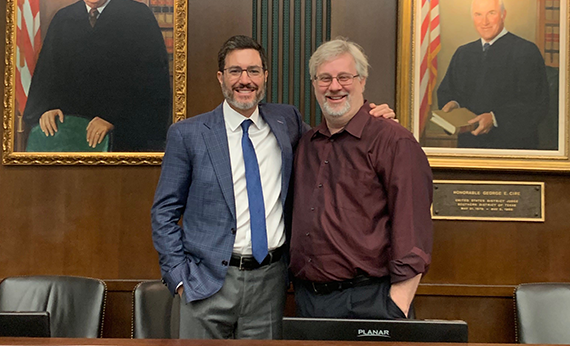
The Judge's Decision in Addicks & Barker Case is Coming
The upstream Addicks & Barker test cases went to trial in May 2019. We are part of the lead team that tried the case. The final hearing occurred on September 13, 2019 in Washington, D.C. We believe the hearing went very well, and continue to believe homeowners' claims against the federal government are very strong.
The case is now officially in the Judge's hands. The Judge did not indicate when he will issue his final decision, but we are hopeful we will receive it any day now. Once the decision is issued, we will post it here on our website.
If you would like to get on board with us, call (888) 695-6993 or click Get Free Consultation.
Trial of upstream test properties completed!
On May 17, 2019 the two week trial of the upstream test cases concluded. As part of the team leading this historic litigation, we believe the trial went very well and believe our team proved everything necessary to win. We do not yet have a decision from the Judge. The judge scheduled a hearing for September 13, 2019 in Washington, D.C., which is the earliest we could learn of his decision.
The low point of the trial for the government came on Day #9 when the Judge struck one of its retained expert witnesses. The government wanted this witness to testify all the test properties were “flood prone.” The judge decided this witness did not offer any scientifically valid expert testimony, and threw him out of the case. The government had paid this “expert” several million dollars for his work.
The government dropped more than 10 witnesses it was scheduled to call to the stand. This includes a number of retained expert witnesses. We estimate the government paid over $20 million to experts it never called to the stand.
This case was unique in many respects, including the field trip we took with the judge to show him the Addicks and Barker projects and numerous homes that flooded in neighborhoods behind the dams.
Over 30 witnesses testified at trial. We heard from:
- Property owners from Lakes on Eldridge, Twin Lakes, Bear Creek, Kelliwood, Cinco Ranch and Canyon Gate;
- Multiple expert witnesses (including hydrology, meteorology, and real estate appraisal and valuation);
- Representatives from the Corps;
- Representatives from Harris County; and
- Representatives from Fort Bend County.
We believe a favorable decision from the judge concerning this trial will go a long way towards accomplishing our ultimate goal of getting all of our clients’ cases resolved for the appropriate amount of just compensation as required by the Fifth Amendment to the U.S. Constitution.
News articles about the Harvey flood trial
- Federal trial in case of Hurricane Harvey goes beyond the courtroom
- Hurricane Harvey victims slog through mud with out-of-town judge
- Trial to determine if government liable for Harvey flooding
- Homeowners fault government for Hurricane Harvey damage (If you don't have a Wall Street Journal subscription, you can read the article for free here: https://www.realtor.com/news/real-estate-news/homeowners-fault-government-for-hurricane-harvey-damage/)
The Judge in the Upstream Addicks & Barker case entered an order on December 15, 2021, denying the certification of the partial class-action. Read the harvey_upstream_opinion_and_order_re_cert.
The Judge in the Upstream Addicks & Barker case entered an order on December 15, 2021, denying the certification of the partial class-action. Read the harvey_upstream_opinion_and_order_re_cert.
On December 15, 2021, Judge Charles F. Lettow of the United States Court of Federal Claims declined to certify a class action in litigation in which thousands of owners of private property located behind the Addicks and Barker reservoir project in Harris County and Fort Bend County, Texas claim the government took their property without just compensation by diverting flood water during Hurricane Harvey in 2017.
Vuk Vujasinovic of VB Attorneys is one of the court-appointed counsel in the litigation and was on the team that won a liability finding for thirteen “test cases” in December 2019. Vujasinovic is designated by the federal judge “to ensure the interests of individual plaintiffs are represented,” and is not among the counsel responsible for class action matters.
Vujasinovic says a motion to certify a class action was filed by other counsel, and denied by Judge Lettow. Judge Lettow’s order indicates the motion for class certification was “DENIED both because of the timing of their request and their failure to satisfy the [necessary] criteria.” Vujasinovic explains that because of this ruling, flood victims should not expect to receive any kind of class action notice in the mail, or otherwise, through which they could join the lawsuit. Instead, Vujasinovic urges flood victims to hire individual counsel now.
Vujasinovic, who represents flood victims in all of the impacted upstream communities, says the litigation will continue to proceed on an individual basis as it has since late 2017. The next step is a trial to determine the just compensation for six of the test cases, which is anticipated to occur in Houston, Texas in March 2022. “The goal is to use our 2019 test case liability victory and apply it to the claims of all of our flood victim clients in order to obtain the just compensation they are owed under the 5th Amendment to the U.S. Constitution.”
Vujasinovic notes that in issuing the December 2019 liability order, Judge Lettow ruled that the government owns a permanent flowage easement over every property that flooded due to the government’s project during Hurricane Harvey. Vujasinovic estimates that 10,000 to 12,000 properties are burdened by this permanent easement, and that the total claimed damages exceed $1 billion.
According to Vujasinovic, now that it is known there will be no class action, it is particularly important for flood victims to hire individual counsel who can enforce their constitutional property rights and obtain the correct amount of just compensation. “Any flood victim who does not properly file their case by the applicable deadline risks being forever barred from recovering any just compensation. They will be giving the government a permanent flowage easement over their property for free. The government can flood their property any time it rains hard enough, without compensation. The government wants as few flood victims as possible to hire counsel and file claims so it won’t have to pay them anything, so it can save as much as possible off the estimated $1 billion it collectively owes property owners in our local communities upstream of the dams.”
Scope of Easement & Date of Taking Order
The compensation order for the six upstream test cases is in! With interest and other allowable items, and reductions for certain offsets, the numbers for the test cases who owned homes that flooded are going to average compensation of up to around $300,000 each. This includes interest beginning in August 2017 at 3.62% compounded semi-annually.
Impacted homeowners who have not hired counsel are strongly advised to do so as soon as possible, as the time to file these claims is quickly running out.
The Judge awarded compensation in three categories for the test cases who sustained structural flooding.
First, real property. The Judge characterized this category as follows: “The award for structurally flooded properties reflects both the fact that the easement grants the government the permanent right to impound water within the homes on the properties, and the structural damage the government caused by taking the easement.”
Second, personal property. This includes “personal property, fixtures and improvements” that were located at the flooded property and destroyed or damaged, such as vehicles, furniture, belongings, etc.
Third, dislocation costs. This is basically money spent on alternative lodging while the flooded property was being restored, such as renting a hotel or a temporary home.
The Judge reduced the awards by the amounts of any direct payments from FEMA.
Every case is individual and compensation will be determined based on each person’s individual damages. The test cases are examples that teach us the methodology to be used for the rest of the cases.
It is recommended all impacted upstream homeowners gather and preserve the following materials:
● Documentation of cost to restore and/or repair your flooded home;
● A list of your personal property, fixtures and improvements that were damaged or destroyed, any photos you may have of these items (before and/or after the flooding), and any documentation you may have indicating the value of such items (when first acquired and/or at the time of the flooding); and
● Documentation of any costs you incurred for temporary lodging while your flooded home was being restored / repaired.
Vuk Vujasinovic of VB Attorneys, who represents homeowners in all of the impacted upstream communities, says “Our goal is to use these victories in the test cases and apply them to the claims of all of our clients in order to get them the just compensation they are owed under the 5th Amendment to the U.S. Constitution.”
Vujasinovic estimates the collective value of the claimed damages exceeds $1 Billion. Vujasinovic points out that anyone who does not hire counsel and file their claim soon will be prohibited from ever recovering any compensation in this matter.
The compensation order for the six upstream test cases is in! With interest and other allowable items, and reductions for certain offsets, the numbers for the test cases who owned homes that flooded are going to average compensation of up to around $300,000 each. This includes interest beginning in August 2017 at 3.62% compounded semi-annually.
Impacted homeowners who have not hired counsel are strongly advised to do so as soon as possible, as the time to file these claims is quickly running out.
The Judge awarded compensation in three categories for the test cases who sustained structural flooding.
First, real property. The Judge characterized this category as follows: “The award for structurally flooded properties reflects both the fact that the easement grants the government the permanent right to impound water within the homes on the properties, and the structural damage the government caused by taking the easement.”
Second, personal property. This includes “personal property, fixtures and improvements” that were located at the flooded property and destroyed or damaged, such as vehicles, furniture, belongings, etc.
Third, dislocation costs. This is basically money spent on alternative lodging while the flooded property was being restored, such as renting a hotel or a temporary home.
The Judge reduced the awards by the amounts of any direct payments from FEMA.
Every case is individual and compensation will be determined based on each person’s individual damages. The test cases are examples that teach us the methodology to be used for the rest of the cases.
It is recommended all impacted upstream homeowners gather and preserve the following materials:
● Documentation of costs to restore and/or repair your flooded home;
● A list of your personal property, fixtures and improvements that were damaged or destroyed, any photos you may have of these items (before and/or after the flooding), and any documentation you may have indicating the value of such items (when first acquired and/or at the time of the flooding); and
● Documentation of any costs you incurred for temporary lodging while your flooded home was being restored / repaired.
Vuk Vujasinovic of VB Attorneys, who represents homeowners in all of the impacted upstream communities, says “Our goal is to use these victories in the test cases and apply them to the claims of all of our clients in order to get them the just compensation they are owed under the 5th Amendment to the U.S. Constitution.”
Vujasinovic estimates the collective value of the claimed damages exceeds $1 Billion. Vujasinovic points out that anyone who does not hire counsel and file their claim soon will be prohibited from ever recovering any compensation in this matter.
The compensation order for the six upstream test cases is in! With interest and other allowable items, and reductions for certain offsets, the numbers for the test cases who owned homes that flooded are going to average compensation of up to around $300,000 each. This includes interest beginning in August 2017 at 3.62% compounded semi-annually.
Impacted homeowners who have not hired counsel are strongly advised to do so as soon as possible, as the time to file these claims is quickly running out.
The Judge awarded compensation in three categories for the test cases who sustained structural flooding.
First, real property. The Judge characterized this category as follows: “The award for structurally flooded properties reflects both the fact that the easement grants the government the permanent right to impound water within the homes on the properties, and the structural damage the government caused by taking the easement.”
Second, personal property. This includes “personal property, fixtures and improvements” that were located at the flooded property and destroyed or damaged, such as vehicles, furniture, belongings, etc.
Third, dislocation costs. This is basically money spent on alternative lodging while the flooded property was being restored, such as renting a hotel or a temporary home.
The Judge reduced the awards by the amounts of any direct payments from FEMA.
Every case is individual and compensation will be determined based on each person’s individual damages. The test cases are examples that teach us the methodology to be used for the rest of the cases.
It is recommended all impacted upstream homeowners gather and preserve the following materials:
● Documentation of costs to restore and/or repair your flooded home;
● A list of your personal property, fixtures and improvements that were damaged or destroyed, any photos you may have of these items (before and/or after the flooding), and any documentation you may have indicating the value of such items (when first acquired and/or at the time of the flooding); and
● Documentation of any costs you incurred for temporary lodging while your flooded home was being restored / repaired.
Vuk Vujasinovic of VB Attorneys, who represents homeowners in all of the impacted upstream communities, says “Our goal is to use these victories in the test cases and apply them to the claims of all of our clients in order to get them the just compensation they are owed under the 5th Amendment to the U.S. Constitution.”
Vujasinovic estimates the collective value of the claimed damages exceeds $1 Billion. Vujasinovic points out that anyone who does not hire counsel and file their claim soon will be prohibited from ever recovering any compensation in this matter.
The compensation order for the six upstream test cases is in! With interest and other allowable items, and reductions for certain offsets, the numbers for the test cases who owned homes that flooded are going to average compensation of up to around $300,000 each. This includes interest beginning in August 2017 at 3.62% compounded semi-annually.
Impacted homeowners who have not hired counsel are strongly advised to do so as soon as possible, as the time to file these claims is quickly running out.
The Judge awarded compensation in three categories for the test cases who sustained structural flooding.
First, real property. The Judge characterized this category as follows: “The award for structurally flooded properties reflects both the fact that the easement grants the government the permanent right to impound water within the homes on the properties, and the structural damage the government caused by taking the easement.”
Second, personal property. This includes “personal property, fixtures and improvements” that were located at the flooded property and destroyed or damaged, such as vehicles, furniture, belongings, etc.
Third, dislocation costs. This is basically money spent on alternative lodging while the flooded property was being restored, such as renting a hotel or a temporary home.
The Judge reduced the awards by the amounts of any direct payments from FEMA.
Every case is individual and compensation will be determined based on each person’s individual damages. The test cases are examples that teach us the methodology to be used for the rest of the cases.
It is recommended all impacted upstream homeowners gather and preserve the following materials:
● Documentation of costs to restore and/or repair your flooded home;
● A list of your personal property, fixtures and improvements that were damaged or destroyed, any photos you may have of these items (before and/or after the flooding), and any documentation you may have indicating the value of such items (when first acquired and/or at the time of the flooding); and
● Documentation of any costs you incurred for temporary lodging while your flooded home was being restored / repaired.
Vuk Vujasinovic of VB Attorneys, who represents homeowners in all of the impacted upstream communities, says “Our goal is to use these victories in the test cases and apply them to the claims of all of our clients in order to get them the just compensation they are owed under the 5th Amendment to the U.S. Constitution.”
Vujasinovic estimates the collective value of the claimed damages exceeds $1 Billion. Vujasinovic points out that anyone who does not hire counsel and file their claim soon will be prohibited from ever recovering any compensation in this matter.
The compensation order for the six upstream test cases is in! With interest and other allowable items, and reductions for certain offsets, the numbers for the test cases who owned homes that flooded are going to average compensation of up to around $300,000 each. This includes interest beginning in August 2017 at 3.62% compounded semi-annually.
Impacted homeowners who have not hired counsel are strongly advised to do so as soon as possible, as the time to file these claims is quickly running out.
The Judge awarded compensation in three categories for the test cases who sustained structural flooding.
First, real property. The Judge characterized this category as follows: “The award for structurally flooded properties reflects both the fact that the easement grants the government the permanent right to impound water within the homes on the properties, and the structural damage the government caused by taking the easement.”
Second, personal property. This includes “personal property, fixtures and improvements” that were located at the flooded property and destroyed or damaged, such as vehicles, furniture, belongings, etc.
Third, dislocation costs. This is basically money spent on alternative lodging while the flooded property was being restored, such as renting a hotel or a temporary home.
The Judge reduced the awards by the amounts of any direct payments from FEMA.
Every case is individual and compensation will be determined based on each person’s individual damages. The test cases are examples that teach us the methodology to be used for the rest of the cases.
It is recommended all impacted upstream homeowners gather and preserve the following materials:
● Documentation of costs to restore and/or repair your flooded home;
● A list of your personal property, fixtures and improvements that were damaged or destroyed, any photos you may have of these items (before and/or after the flooding), and any documentation you may have indicating the value of such items (when first acquired and/or at the time of the flooding); and
● Documentation of any costs you incurred for temporary lodging while your flooded home was being restored / repaired.
Vuk Vujasinovic of VB Attorneys, who represents homeowners in all of the impacted upstream communities, says “Our goal is to use these victories in the test cases and apply them to the claims of all of our clients in order to get them the just compensation they are owed under the 5th Amendment to the U.S. Constitution.”
Vujasinovic estimates the collective value of the claimed damages exceeds $1 Billion. Vujasinovic points out that anyone who does not hire counsel and file their claim soon will be prohibited from ever recovering any compensation in this matter.
The compensation order for the six upstream test cases is in! With interest and other allowable items, and reductions for certain offsets, the numbers for the test cases who owned homes that flooded are going to average compensation of up to around $300,000 each. This includes interest beginning in August 2017 at 3.62% compounded semi-annually.
Impacted homeowners who have not hired counsel are strongly advised to do so as soon as possible, as the time to file these claims is quickly running out.
The Judge awarded compensation in three categories for the test cases who sustained structural flooding.
First, real property. The Judge characterized this category as follows: “The award for structurally flooded properties reflects both the fact that the easement grants the government the permanent right to impound water within the homes on the properties, and the structural damage the government caused by taking the easement.”
Second, personal property. This includes “personal property, fixtures and improvements” that were located at the flooded property and destroyed or damaged, such as vehicles, furniture, belongings, etc.
Third, dislocation costs. This is basically money spent on alternative lodging while the flooded property was being restored, such as renting a hotel or a temporary home.
The Judge reduced the awards by the amounts of any direct payments from FEMA.
Every case is individual and compensation will be determined based on each person’s individual damages. The test cases are examples that teach us the methodology to be used for the rest of the cases.
It is recommended all impacted upstream homeowners gather and preserve the following materials:
● Documentation of costs to restore and/or repair your flooded home;
● A list of your personal property, fixtures and improvements that were damaged or destroyed, any photos you may have of these items (before and/or after the flooding), and any documentation you may have indicating the value of such items (when first acquired and/or at the time of the flooding); and
● Documentation of any costs you incurred for temporary lodging while your flooded home was being restored / repaired.
Vuk Vujasinovic of VB Attorneys, who represents homeowners in all of the impacted upstream communities, says “Our goal is to use these victories in the test cases and apply them to the claims of all of our clients in order to get them the just compensation they are owed under the 5th Amendment to the U.S. Constitution.”
Vujasinovic estimates the collective value of the claimed damages exceeds $1 Billion. Vujasinovic points out that anyone who does not hire counsel and file their claim soon will be prohibited from ever recovering any compensation in this matter.
Federal government maps show who was flooded by the Addicks and Barker project during Harvey
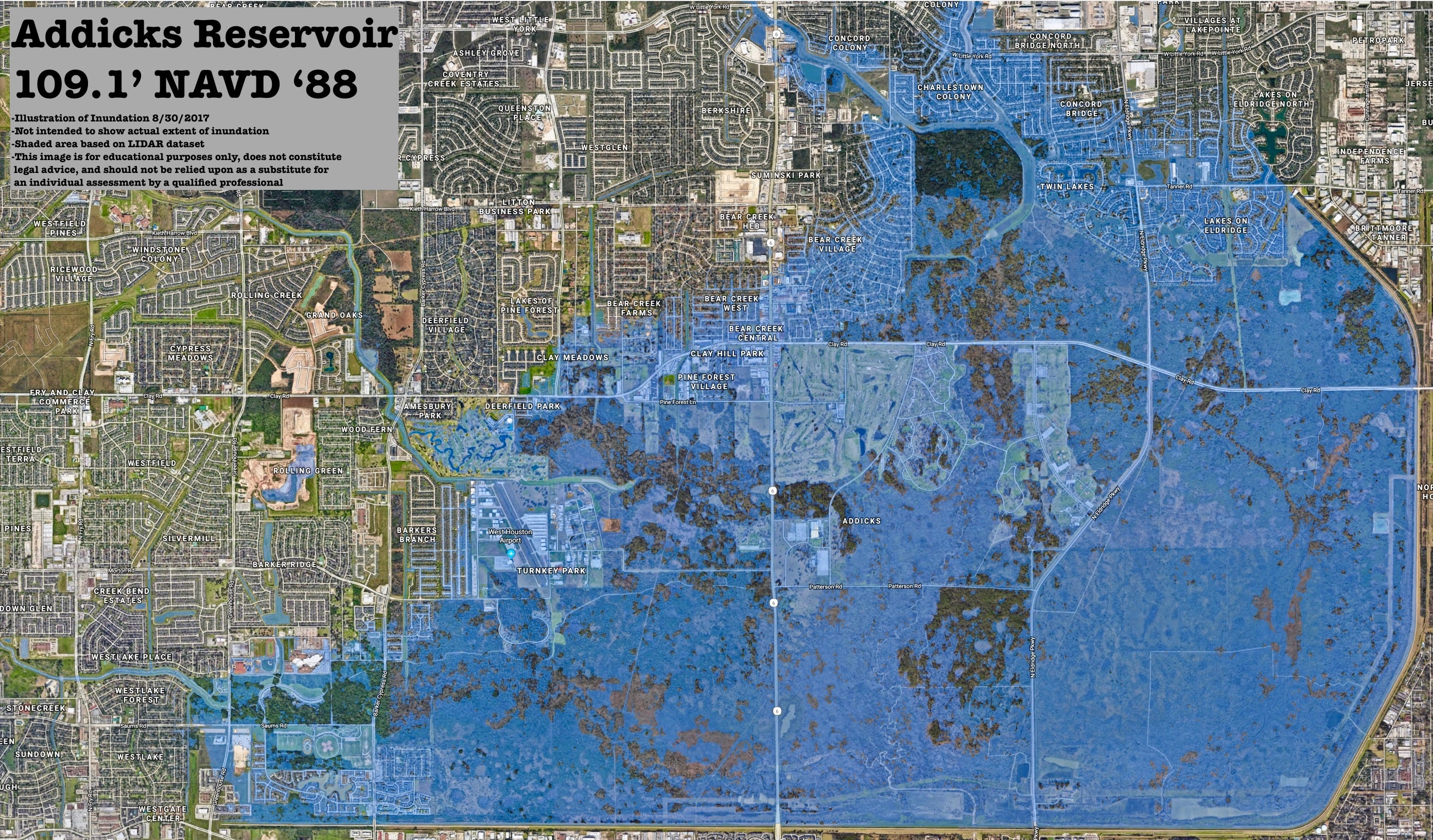
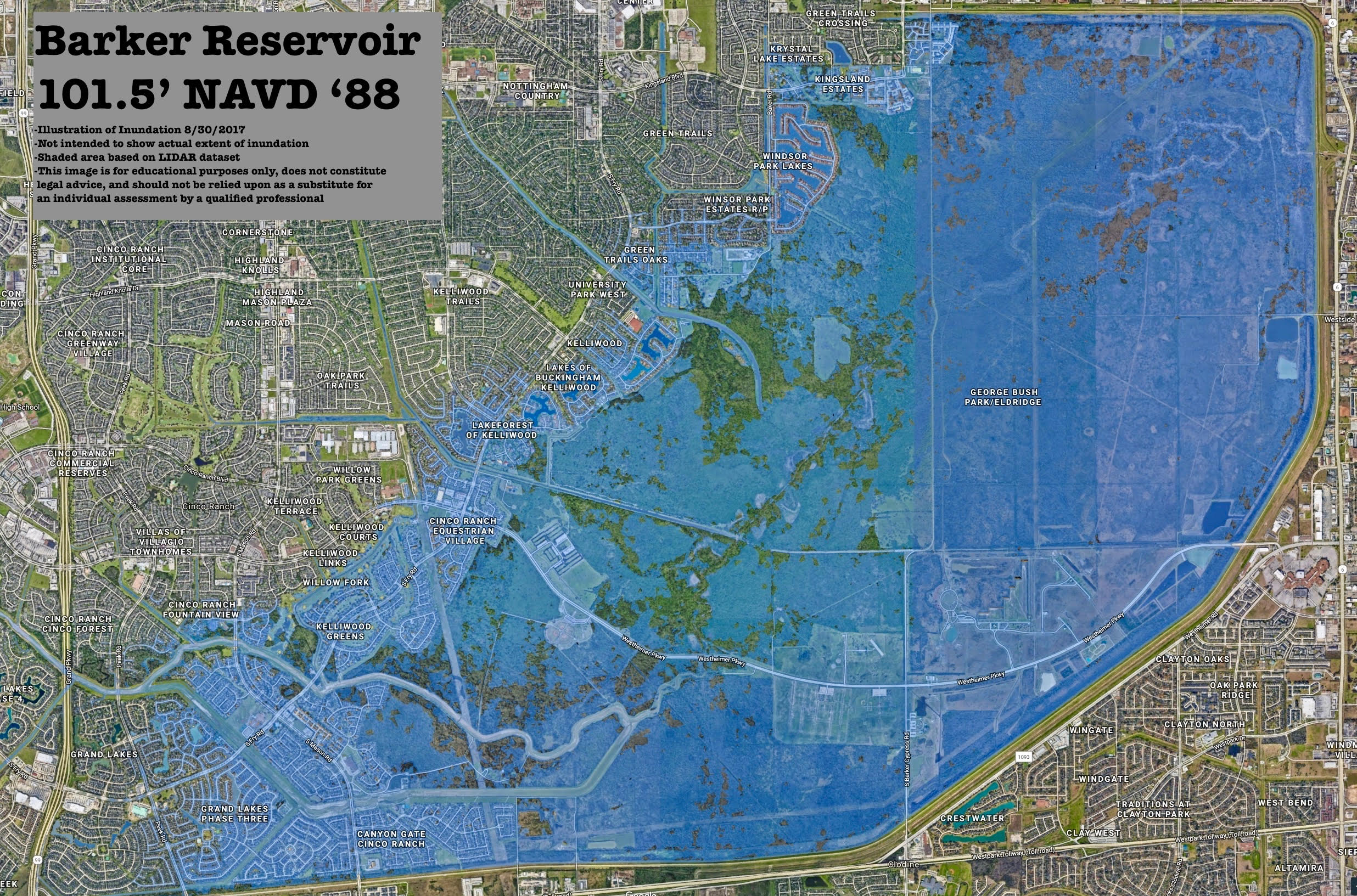
The federal government designed its Addicks and Barker dams and reservoirs to flood thousands of private properties in the event of a large enough storm. That is exactly what happened during Harvey, when over 7,000 acres of private property behind the dams (“upstream”) were flooded due to the government’s project.
Following Harvey, the federal government created maps illustrating which private properties were flooded by its project as of August 30, 2017 (see above).
Addicks reservoir flooded communities including: Lakes on Eldridge, Twin Lakes, Concord Bridge, Charleston Colony, Concord Colony, Bear Creek, Pine Forest Village, Savannah Estates, and Georgetown Colony.
Barker reservoir flooded communities including: Canyon Gate, Cinco Ranch, Grand Lakes Phase Three, Kelliwood Greens, Kelliwood Park, Willowfork, Kelliwood Lakes, Cinco Ranch Equestrian Village, Lakeforest of Kelliwood, Lakes of Buckingham Kelliwood, Green Trails Oaks, Windsor Park Estates, Windsor Park Lakes, and Kingsland Estates.
About this flood litigation:
- Trial of test cases begins May 6, 2019
- Government documents and testimony, and expert witnesses, support property owners’ claims
- Not a class action
- Property owners can still join
- Property owners can join even if they received payments from insurance (including flood) and FEMA, or an SBA loan
About our law firm:
- Appointed by judge to be part of leadership for upstream Individual (not class action) claims
- Represent individual flood victims in 70+ communities around Addicks and Barker
- No fee unless and until you win compensation
- Board Certified by the Texas Board of Legal Specialization
- Houston-based law practice for 20+ years
If you would like a Free Consultation, please contact us and ask to speak to our court-appointed counsel.
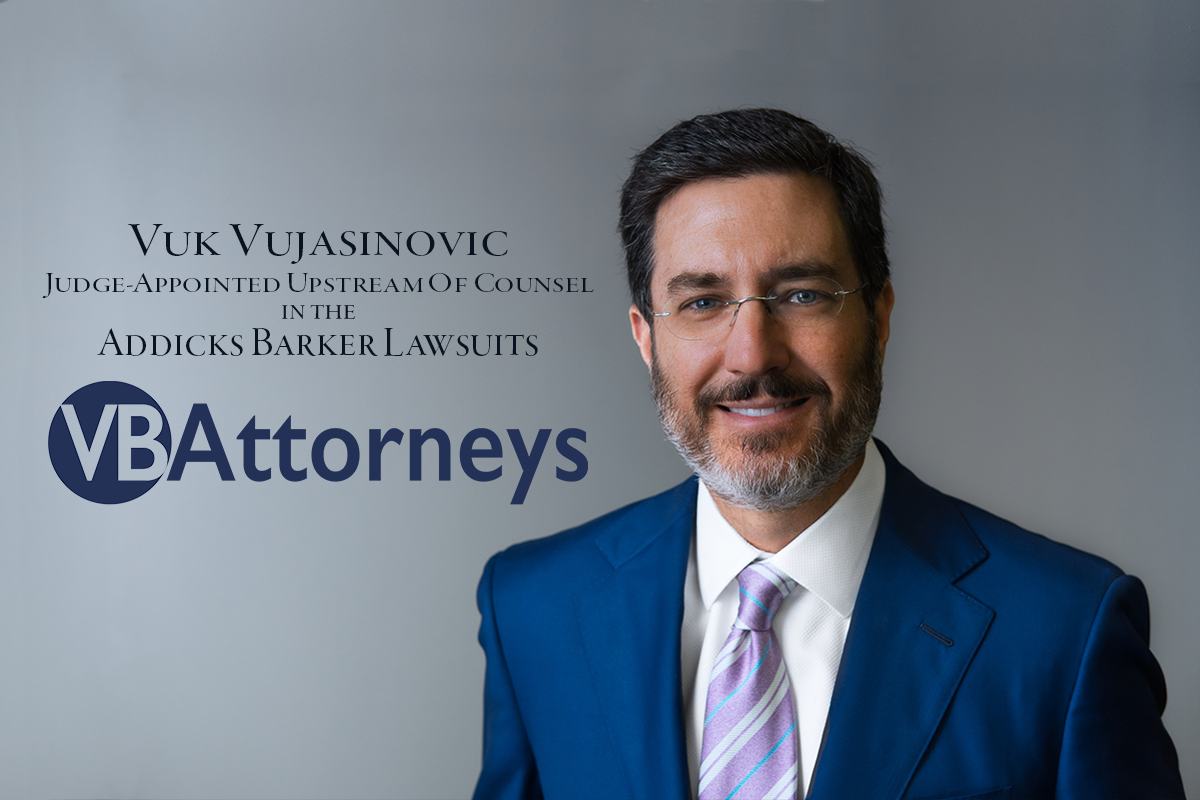
In a blow to the government’s arguments, Judge declines to throw Upstream cases out of court.

Government’s motion to dismiss not granted
The government asked the Judge to throw the upstream cases out of court, by filing what is called a “motion to dismiss.” The Judge held a hearing on the motion in Houston federal court on May 16, 2018, and issued an Order on May 24. In that order, the judge declined to throw the upstream cases out of court at this time. Here are some quotes from the Order:
- “the dams could impound water to flood thousands of additional acres of private property”
- “The Corps appears to have been long aware that its management plans could result in the flooding of private property”
- “the Addicks and Barker Reservoirs flooded 3,973 acres and 3,081 acres of private property”
- “The government acted when it built and then modified the dams in such a way that they could and did impound storm water behind the dams on both government and private property”
- Addressing the government’s legal argument about “frequency” - “the government is mistaken”
- “the Corps appeared indifferent to the risk to nearby private property owners, taking no action to reduce that risk or to obtain authorizations from those owners to impound water on their land”
The Judge concluded his Order by stating he is deferring any ruling on the motion to dismiss until trial. We continue to feel very good about our position that the cases should not be thrown out of court.
Click here to read the Order.
The case schedule
At the hearing, the Judge also discussed the case schedule. The Judge indicated the upstream test cases will go to trial in February 2019. This is still an expedited schedule, which is great news for all upstream flood victims.
“Class action” questions
The Judge was asked at the hearing if he is inclined to certify some type of class action in the upstream litigation, and his response was: “I’m not.” The Judge cited several “problems” he sees with addressing this litigation through a class action. In the May 24 Order, the Judge further confirmed: “The proceedings in both of these sub-master dockets have followed the pattern used for multi-district litigation.” This litigation is continuing to move forward as a group of individual cases, and not as a class action.
Super Lawyers magazine recognizes Vuk for work after Harvey
Vuk has been recognized by Super Lawyers magazine for his work after Harvey. The magazine spoke with Vuk and several other attorneys from Houston who volunteered their time, resources, and experience to help people in need.
In the article, Vuk talks about helping people gut houses and clean up after the storm. He says, "Floodwaters are particularly nasty and toxic... They're sitting around for days, sometimes weeks – and these homes were just swilling in this. Their belongings were destroyed. It's not easy to go into a place where you have a lot of memories and just take a sledgehammer and whack it."
New York Times video features client of VB Attorneys
On Thursday, March 22, 2018, the New York Times published a powerful video story featuring one of our clients, Lisa Perez. Ms. Perez lives in Cinco Ranch Southpark, and her home was flooded by waters backing up from the Barker reservoir.
This story includes Judge Robert Hebert’s quote, referring to communities upstream of Addicks Barker: “Harvey didn’t flood them. The federal government flooded them.” Based on our work in this litigation, this statement is 100% true. The following information reported in this story is also true, based on our analysis:
- The federal government has known since 1940 that certain storms would flood thousands of upstream private properties (in fact, the reservoirs were designed to flood them); and
- The federal government could have purchased these properties, but chose not to, paving the way for the area to be fully developed with private residential homes.
Sadly, the story doesn’t end there. The federal government actually predicted in the days before peak flooding that over 15,000 private properties upstream of Addicks and Barker would flood due to the design and operation of those reservoirs, impacting almost 50,000 people. The government’s projection was correct, as this is precisely what happened as of August 30, 2017. Inexplicably, the federal government chose not to tell the public about its projections, robbing our community of any reasonable opportunity to at least save some valuable personal possessions before the destructive reservoir waters washed them all away forever.
Get Latest Updates by Watching a Video of Our March 5 Online Town Hall
On Monday, March 5, Vuk Vujasinovic, judge-appointed of counsel in the Addicks Barker litigation, gave an update on latest case developments and answered questions, via Facebook Live.
Click here to access a video of this presentation.
Vuk’s update on this litigation included a discussion of the following topics:
* Answer filed by Government
* Motion to Dismiss
* Test Cases
* Case Schedule
* Individual Case / Class Action
* Hydrology Mapping
* Flood Insurance / FEMA implications
* Post-Harvey home sale
Why hire VB Attorneys for your flood claim?
* Judge-appointed of counsel for Addicks Barker cases
* Board Certified over a decade
* Hundreds of millions recovered
* Nationally recognized
* Houston local over 20 years
* Free Consultations
* No fee unless and until you win
Vuk Vujasinovic of VB Attorneys appointed by Chief Judge as Of Counsel in Addicks & Barker Flood Litigation
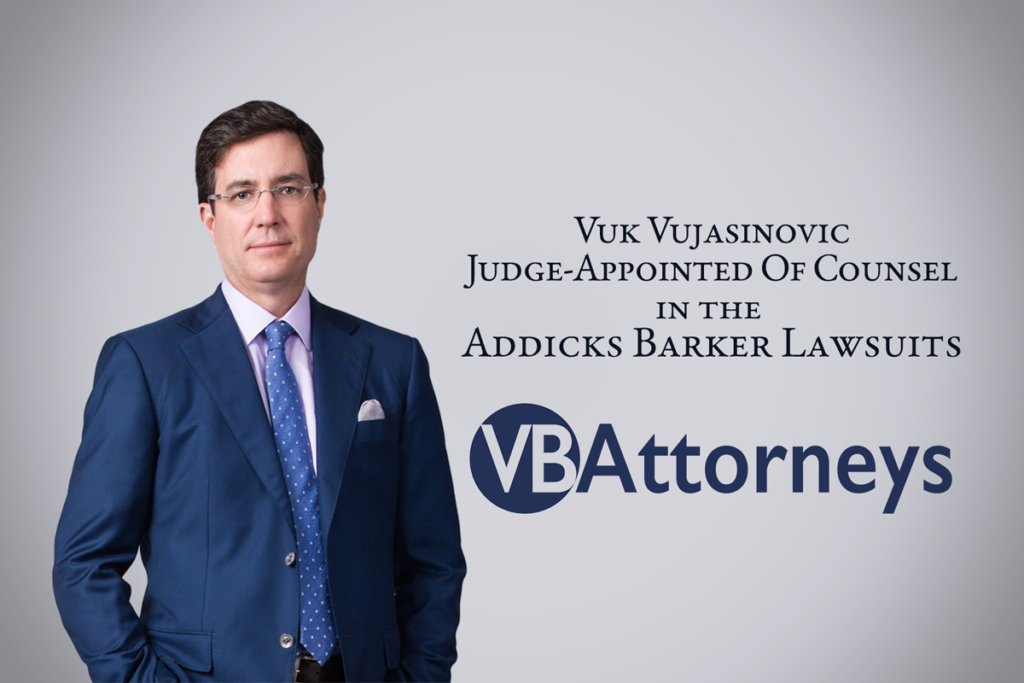
On November 20, 2017, Chief Judge Susan G. Braden issued an Order in the Addicks & Barker reservoir flooding lawsuits which included an appointment of “Mr. Vuk Vujasinovic to serve as Of Counsel . . . to ensure the interests of individual plaintiffs who, at this point, do not seek class certification.” Judge Braden’s Order elaborated as follows:
“Mr. Vujasinovic graduated from the Houston Law Center where he received a Juris Doctor and was Editor of the Houston Law Review. Mr. Vujasinovic is a founding partner of Vujasinovic & Beckcom LLP, a Houston law firm specializing in complex civil litigation. Before co-founding VB Attorneys, Mr. Vujasinovic specialized in complex litigation at Shook, Hardy & Bacon. Mr. Vujasinovic is admitted to the bar of the United States Court of Federal Claims.”
Chief Judge Braden went on to specify that Mr. Vujasinovic satisfies “the criteria for selection, set out in the MANUAL FOR COMPLEX LITIGATION (4th ed. 2004) and MDL Standards and Best Practices, DUKE LAW SCHOOL CENTER FOR JUDICIAL STUDIES (Sept. 1, 2014).” The Order pertains to pre-trial jurisdiction discovery, the government’s motion to dismiss per certain court rules, and scheduling, and was entered in an upstream track of the litigation.
VB Attorneys is proud to have been appointed to this lead role in the litigation, and we are eager to continue our hard work protecting our clients’ property rights.
Addicks Barker Flood Litigation Updates
- Chief Judge issues calendar of deadlines (first case deadline is December 8, 2017).
- Chief Judge appoints leadership counsel to lead the litigation, including Vuk Vujasinovic of VB Attorneys.
- Chief Judge establishes two litigation tracks: downstream and upstream.
- Projection issued of 10,000 to 16,000 flood victims owning property upstream.
- Projection issued of 4,000 to 5,000 flood victims owning property downstream.
- Collective financial losses projected to exceed $1 Billion.
Do you own a home or business that was flooded by reservoir waters?
If so, you qualify to be included in our group of clients who are asserting their constitutional right to be compensated by the government for “taking” their property. We are accepting clients with properties downstream and upstream from the Addicks and Barker reservoirs. We are filing claims for a group of individual clients who will receive personalized attention.
On October 2 and December 5, 2017, we filed Complaints in the U.S. Court of Federal Claims on behalf of our large group of our clients seeking just compensation for the flooding of their properties by reservoir waters. We are continuing to accept clients.
Our current clients own properties in over 60 neighborhoods and complexes in and around Katy and Houston, including the following (if your neighborhood does not appear here, contact us and we will analyze for you):
Ashford Forest | Aspen Club Condominiums | Barker Court Townhomes | Barwood | Bear Creek Village | Canyon Gate Cinco Ranch | Charlestown Colony | Cinco at Willofork | Cinco Ranch Equestrian Village | Cinco Ranch Greenway Village | Cinco Ranch Meadow Place | Cinco Ranch Southpark | Concord Bridge | Equestrian Park | Fairways at Kelliwood | Fleetwood | Fonn Villages | Gaywood | Georgetown Townhomes | Grand Lakes | Grand Lakes Phase Three | Grand Mission | Greens at Willow Fork | Jamestown Colony | Kelliwood Greens | Kingsland Estates | Lakeside Forest | Marlborough Square | Mayde Creek Farms | Memorial Bend | Memorial Bend Place Condominiums | Memorial Drive Townhomes | Park Harbor Estates | Parklake Village | Parkway Villages | Pine Forest Village | Ria Ranch | River Forest | Shapard Trace | Somerset Place | Stone Gate at Canyon Gate | Tealwood | The Pines Condominiums | Walnut Bend | Woods on Memorial
We work on a contingency fee, so you do not owe us anything unless and until we win your case, at which time we would be paid a portion of your winnings. You have nothing to lose.
For a free consultation, complete the “Contact Us” form on this website. You may also call us at (888) 695-6993 or come see us at our offices in West Houston.
We are uniquely qualified to handle these cases
The Harvey inverse condemnation cases will likely turn in large part on the science of surface water resources engineering, hydrology and hydraulics. Our firm happens to be on the current forefront of these very hydrographic issues that will be presented by these Hurricane Harvey claims lawsuits based on work we did on a case last year in which we obtained a verdict of $17,720,000, resulting in a judgment of over $20,000,000. According to the Texas Lawyer, this was among the largest verdicts in Texas last year.
That case involved a fatality during construction of a bridge over Lake Brazos as part of the new Baylor football stadium project. One issue involved the application of marine law. This required us to analyze issues concerning reservoir use, water surface elevations, water flow levels, stream gages, USGS gage data, navigability, and passage of water over and through a dam.
These are precisely the issues we are currently analyzing with respect to the downstream release and upstream accumulation of water from the Addicks and Barker reservoirs. The dam in that case was even operated by the same government entity that operates the Addicks and Barker facilities: the U.S. Army Corps of Engineers.
We hired and worked with a registered civil engineer expert with over 30 years of experience in water resources engineering, modeling and evaluation of surface water resource systems, forensic hydrology and hydraulics, and alternative flood control measures. Our expert prepared a detailed hydrographic analysis for us, reducing it to a report.
We are conducting the same kind of hydrographic analysis in our cases concerning the downstream release and upstream accumulation of water from the Addicks and Barker reservoirs. We are uniquely equipped to do so because we conducted the same analysis as recently as last year in a very significant case. This benefits our clients because we already know how to confront these issues, which greatly increases our chances of success, and also saves costs because there is no need to re-invent the wheel.
The firm's founders, Vuk Vujasinovic and Brian Beckcom, have each been practicing law for approximately 20 years. Vuk and Brian are both Board Certified in Personal Injury Trial Law by the Texas Board of Legal Specialization, and have been so certified for over a decade. In fact, three of the six lawyers at the firm hold this certification. The firm is highly experienced in handling large, high-stakes civil cases for large groups of clients, with an established track record of success.
What must be proven to win this kind of takings or inverse condemnation case?
There is legal authority under the constitutions of the United States and Texas, and under federal and state case law, that you have a potential “takings” claim (also called “inverse condemnation”) if the government chooses to flood your property, even if the flooding is temporary. You do not have to claim or show that the government did anything wrong. The government sacrificed your property for the greater public good, and you have the constitutional right to be compensated by the government because you took this bullet for the community.
According to the Supreme Court of the United States, "no magic formula enables a court to judge, in every case, whether a given government interference with property is a taking," and "most takings claims turn on situation-specific factual inquiries." Courts have been instructed to consider the following factors in deciding the merits of a taking or inverse condemnation case:
- "The degree to which the invasion is intended or is the foreseeable result of authorized government action";
- "The character of the land at issue and the owner's 'reasonable investment-backed expectations regarding the land's use"; and
- "Severity of the interference."
Courts have also crafted some factors specifically for takings cases involving government flooding of properties:
- Property owners must "show that [the government] caused additional flooding beyond what would have occurred under the same conditions had the government not constructed [the reservoirs]"; and
- Challenge what the government must show: The "benefits of the [reservoirs] to each tract of land on the whole offsets the damages suffered to the individual tract under the relevant benefits test of [another case]."
So the bottom line is this: these claims are analyzed by courts on a fact-intensive case-by-case basis. Courts will look at where your neighborhood is located, which street you are on, as well as your specific, one-of-a-kind address. We are going to work with our experts in trying to establish a takings case for each case we accept, no matter where our client's property is located within the inundated areas.
We take the flooding caused by Hurricane Harvey personally, and stand ready to help you preserve your constitutional property rights
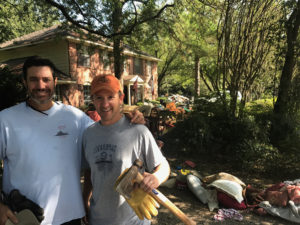
Our law firm is based on the west side of Houston, and most of our lawyers and other employees live in this area. Our firm's founders, Vuk Vujasinovic and Brian Beckcom, live with their families in west Houston. We have had a first-hand look at the devastation caused by the flooding brought on by Hurricane Harvey, and by the government's release of the Addicks and Barker reservoirs. Most of us suffered losses in the flooding. We have been busy helping our families, friends, and fellow citizens gut their homes to prevent mold so they can hopefully re-build. Vuk grew up in Kingwood, an area also hit hard by flooding, and still has close family and friends there.
Our investigation continues to uncover evidence we believe supports our clients’ constitutional property claims
One of the main items we must prove in these kinds of cases is that the government knew your property would be among those inundated with water and damaged by the release of water downstream from the Addicks and Barker reservoirs or by the accumulation of water onto private properties upstream. We are uncovering evidence supporting these claims.
The U.S. Army Corps of Engineers (“USACE”) analyzed the Addicks and Barker reservoirs almost 10 years ago. The purpose of this analysis was to understand and communicate “water inundation risks to stakeholders located in and around the reservoirs.” The government’s findings included:
- “there are significant residential encroachments within the footprints of the maximum reservoir flood pools”;
- “substantial residential neighborhoods and commercial developments are located upstream and adjacent to the federal project lands as well as along the channel below the dams and throughout the Buffalo Bayou watersheds”;
- “major thoroughfares crossing through the reservoirs are subject to inundation”; and
- the decision on when and how much to open or close the dams is a team effort of the” USACE.
A related analysis conducted by the USACE during the same time period focused on “assessment of potential flood damage” and concluded the following areas would be flooded at certain flow levels: “homes in the vicinity of West Beltway Bridge” and homes “between the bridges over Buffalo Bayou at North Wilcrest Drive … and Chimney Rock Road.”
Statements by Richard Long, Manager of the USACE responsible for operations of the Addicks and Barker reservoirs, support our clients’ claims:
- “This area [upstream properties] is designed to hold that water if necessary. It’s unfortunate for you all, but that’s how it’s designed.”
- “We know it’s putting people, making people hurt upstream, and we know it’s making people hurt downstream, but we have to ... operate the reservoirs for the entire population.”
- “We have opened the gates and we are actually flooding homes downstream now due to our releases.”
- “Did we know you would have five-foot of water in your home? We knew that if we got this event, there will be homes with water in them, yes.”
- “This is the first time we have flooded homes located adjacent to and upstream from the property.”
- “The Corps also can impound water on more land than it owns, so it could flood properties behind or beside the reservoirs.”
Some real estate documents also contain evidence supporting our clients’ claims that the government intentionally flooded private properties. For example, some plats for some of the Katy area upstream neighborhoods contain the following fine print: “subject to extended controlled inundation under the management of the U.S. Army Corps of Engineers.”



